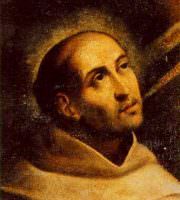About John of the Cross
Saint John of the Cross, in spanish: San Juan de la Cruz (1542 – 1591), was spanish mystic, a roman catholic saint, a carmelite friar and a priest who was born at Fontiveros, Old Castile. He is also known for his writings. Both his poetry and his studies on the growth of the soul are considered the summit of mystical Spanish literature and one of the peaks of all Spanish literature. His writings were first published in 1618 by Diego de Salablanca. The numerical divisions in the work, still used by modern editions of the text, were introduced by Salablanca (they were not in John's original writings) in order to help make the work more manageable for the reader. The Spiritual Canticle was first included in the 1630 edition, produced by Fray Jeronimo de San José, at Madrid. This edition was largely followed by later editors, although editions in the seventeenth and eighteenth centuries gradually included a few more poems and letters.St. John of the Cross is considered one of the foremost poets in the Spanish language. Although his complete poems add up to fewer than 2500 verses, two of them — the Spiritual Canticle and the Dark Night of the Soul — are widely considered masterpieces of Spanish poetry, both for their formal stylistic point of view and their rich symbolism and imagery. His theological works often consist of commentaries on these poems
However, a strong argument can also be made for contemporary Spanish literary influences on John. This case was first made in detail by Dámaso Alonso, who believed that as well as drawing from scripture, John was transforming non-religious, profane themes, derived from popular songs (romanceros) into religious poetry; Alonso argued that John was particularly influenced by the works of the Spanish Renaissance poets Garcilaso de la Vega and Boscán. Certainly, John does appear to have used Garcilaso's verse forms in his own poetry, in particular in the Spiritual Canticle, Dark Night, and Living Flame of Love. Alongside the various biblical images noted above, for example, exist in John's poems many new Renaissance symbols of pastoral love, prominent in the poetry of Garcilaso and Boscán, such as sirens, nightingales, nymphs, doves and shepherds. Moreover, in the Prologue to the Living Flame, John states that the composition of these lyric lines is like those that in Boscán are given a religious meaning.
Others, though, have questioned the evidence for precisely how John might have been influenced by Boscan and Garcilaso. Dámaso Alonso argued that John must have read the newly published 1575 edition of the poets in Ávila, shortly before his imprisonment in Toledo, and that this must have been the key influence which rekindled in John memories of his own reading of Garcilaso as a young student of the Jesuits in Medina del Campo. However, Peter Thompson disputes this, arguing it is not definite John would have been familiar with Garcilaso from an early age, and even so the influence has been overemphasised by other commentators.
Browse all poems and texts published on John of the Cross









